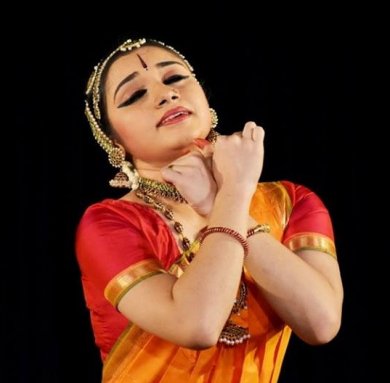
|   |

|   |
Aesthetic beauty of dance and music - JoŽl Riou Photo: Prithvi Krishna January 10, 2019 Meera Sreenarayanan opened her morning recital at the Music Academy on Jan 4, 2019 with a Shloka and a Narasimha Kavithuvam during which she (almost) constantly maintained expressions with her eyes wide open. The piece de resistance was to follow... Although scholars may disagree on the name of the first dancer who performed the varnam "Danike...", the presentation of this varnam in this recital assumed it was created for the courtesan dancer Mannargudi Meenakshi at the court of Marathi King, Sivaji II of Thanjavur (who ruled between 1832 and 1855). In a way, the big hall of the Music Academy Madras replaced the court of King Sivaji II, and the dancer Meera Sreenarayanan played the role of Mannargudi Meenakshi, who interceded with the king to convince him of the love of another woman. The choreography of the varnam attempted to reconstruct the relaxed atmosphere that could reign in these court recitals. Throughout the performance the dancer kept an extremely seductive attitude towards the king, (who is none other than the audience) without disobeying the etiquette of the court. Thus, the dance started with a customary salaam to greet the Maharajah of Thanjavur. The dancer's interactions with the musicians were especially convincing, since even when she seems to give them commands (such as indicating the tempo she wants), you could really feel like she was in charge. I do not know how much freedom the dancer was given to improvise in certain passages, but in particular, the arudis were absolutely delightful in terms of interactions between the dancer and the musicians, as if they were discovering the dancer's intention on the spot. In the pallavi, Meera as Mannargudi Meenakshi tries to convince the king to come along and join with the other woman, who seeks to unite with him; we find the usual imagery with flowers and bees, but done with much more intensity here. In anupallavi, the king is described as a devotee of Shiva. A number of Shaivite rituals are performed and we recognize the appearance of the king, who as a courageous warrior performs a puja for his sword. During this ceremony, his eyes seem attracted towards a certain woman...  It is suggested that the king is also a connoisseur of the arts, who rewards the courtly artists who please him: at some point in the choreography, it was as if the audience had offered a very precious ring to Meera Sreenarayanan. The love sentiment develops even more in the second part of the varnam. The varnam was a delight in abhinaya, but the pure dance did not convince as much as the abhinaya. One of the reasons is that it is the dancer herself who composed and choreographed the jatis. I loved the first one, but the others did not seem very musical - a lot of back and forth in Tisra nadai and long intervals of silence - to follow the tala seemed to me almost impossible. In araimandi, there was less contrast between the beating of the feet: one could not really hear the 'music' of her steps. The recitation of the jathis by Indira Kadambi was lesser because her voice was not amplified enough. Rhythmically over complicated pure dance sections is an unfortunate general trend I have observed in many programs during this margazhi season. My general impression is to have attended a great morning. The standing ovation received by the dancer at the end of the show suggests that the public may be ready to accept this type of dance that focuses on seduction and love. Hopefully this dancer will continue and inspire others to explore this wonderful tradition of court dancers (who knew music, poetry, languages, dance). I had already had the opportunity to have a glimpse of this tradition during the scholarly conference "Temple, Court, Salon, Stage: Crafting Dance Repertoire in South India" organised by Tiziana Leucci, Davesh Soneji and Dominic Goodall in Paris in 2015. I am very happy to have seen this varnam. To set up Danike, the dancer was assisted by Jitendra Krishna with whom I often had the opportunity to discuss dance. I am very happy with the success of this performance. The recital continued with a wonderful Kshetrayya padam. Most of the time, only the eyes of the dancer were used to express the gossip of a group of women about another woman who seemed to have lost her sense of respectability by falling in love with Lord Krishna. I did not enjoy the performance of the dancer in the ashtapadi "Yahi Madhava" as much as the previous pieces. I felt Radha's despair was more over-acted, especially when the dancer was showing her tears. As a conclusion of the performance was the thillana choreographed by Narmada (Guru of Indira Kadambi). The musicians: Bijeesh Krishna - vocal, Charudutt - mridangam, Easwar Ramakrishnan - violin, Sujith Naik - flute, Jayachandran Surendran - advisor iconography. I have enjoyed the aesthetic beauty of dance and music woven together with the appropriate amount of intricacies. Associate Professor of Mathematics at Paris South University, JoŽl Riou is a longtime rasika of Indian dances. Besides being initiated to the dance, he is currently studying the nuances of nattuvangam with Nattuvanar Guru Kuttalam M. Selvam. This review is a transition of a note (in French) from his weblog: http://jriou.org/blog/ |